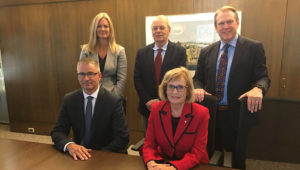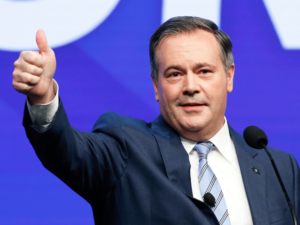Analysis and Opinion
On Thursday afternoon, 24 February Travis Toews tabled his fourth budget. From the standpoint of the United Conservative Party, the budget was an unadulterated triumph. Sure, higher oil prices had something to do with the anticipated surplus in 2022-23 (“a traffic cone could balance Alberta’s budget,” NDP opposition leader Rachel Notley proclaimed before the speech). admitted Toews to interviewers, but other revenue sources were healthier. By sticking to the fiscal plan as outlined in September 2019 by the MacKinnon panel, the government had done the hard lifting of keeping expenses from growing and attracting investment and Albertans were now reaping the fiscal and economic rewards.

In this post, I examine the budget address of Toews, its key messages and its implications for the May 2023 provincial election. Another post will examine the numbers in the 2022-23 budget.
Health Care
As expected, the government was using some of the extra resource revenue to address problems in the province’s health care system. Terming these and other various increases as “investments”, the government was properly responding to the cracks in Alberta’s health infrastructure- intensive care beds and the surgical backlogs made evident by the government’s handling of the pandemic. Unexpectedly, the finance minister was effusive in his praise for Alberta’s health care workers’ contributions in combatting COVID.

I would also like to thank the nurses, doctors and frontline healthcare workers who sacrificially served Albertans over the last year.
Your contribution did not go unnoticed, and on behalf of all Albertans … Thank You!!
The past two years has exposed a systemic lack of margin within our healthcare system and while this has, at times, put considerable strain on our hospitals and front-line workers, it has been exceptionally instructive and brought into sharp focus the areas of deficit, specifically, surgical, ICU and critical care capacity.
By identifying and addressing these challenges, we will substantially improve our ability to not only cope with future health care crises, but to more effectively address the ongoing basic health needs of Albertans.
Fiscal Anchors
Toews structured the first part of his speech about the government adhering to three “fiscal anchors.” These anchors are: a limit of net debt to GDP; bringing Alberta’s per capita public expenditures in line with the provinces of B.C., Ontario, and Quebec; and making Alberta a more attractive place to invest.
The biggest applause for Toews came as he built up to the punch line that the government was going to meet its 2019 election promise of achieving a balanced budget.
The minister was gleeful as he contrasted the different fiscal approaches of the NDP with the UCP. The NDP regime was characterized by “increased government spending, increased personal taxes, corporate taxes, a carbon tax resulting in “an exodus of investment, economic decline, massive job loss, and perpetual deficits.”
Toews characterized the results of the UCP approach in hyperbolic terms:
Investment is pouring into this province across regions and sectors, and more jobs have been created than lost in the downturn.
Moreover, economic growth is creating expanded fiscal capacity, resulting in additional government revenues.
In fact, Mr. Speaker, we will collect roughly $400 million more in annual corporate tax revenue at an 8% rate than the previous government did at 12%, which speaks to the incredible investment climate we’ve restored in the last 3 years.
These points will make it into election campaign materials and will no doubt be capably rebutted by the NDP. While the statement is factually true that the 8 per cent corporate income tax (CIT) rate brought in more money than before, the comparison is meaningless. The budget itself reported a stunning 63 per cent increase in corporate profits (p. 15 of Fiscal Plan). What Alberta taxpayers should be asking is what the extra four percent- equivalent to about $2-billion- could be doing in government coffers rather than in the pockets of corporate executives, shareholders and medium sized family-owned corporations. It would be interesting to see the correlation between those who have benefitted handsomely from the CIT cuts and the UCP donor base.
Investment boom
On investment, higher capital expenditures by the Alberta oilpatch are resuming. However, the investment levels estimated in the economic forecast will only reach levels of about 50 per cent of those reached in the last boom in 2014, when oilsands expansion was in full gear (chart on p. 78). Indeed, the budget projects total investment levels won’t reach the level of 2015 by 2025. That said, the budget is forecasting lower than current market levels of oil prices in the three-year forecast period, so if higher oil prices stay, investment will be higher than investment. It is in r industries other than the oil and gas sector that investment pickup is anticipated.
There is a great deal of global capital finding a safe home in Alberta because we have created, by a wide margin, the best environment for investment in the nation
Toews referred to the government’s value proposition to businesses in the form of its red tape reduction exercise. According to Toews, this laudatory effort resulted in Canfor closing four B.C. sawmills and purchasing three Alberta mills as an example of the benefits of red tape reduction. How this actually adds new investment is an obvious question. How safe sawmill operators in Alberta will be, compared to their British Columbia brethren from a health and safety perspective, remains to be seen.
Toews was pleased to declare that, according to the Conference Board of Canada, Desjardins, and TD Economics, Alberta would lead the nation in 2022 in economic growth. He observed that Alberta broke its venture capital record for a third year in a row. Yet, the reality is that Alberta seriously lags British Columbia, Ontario and Quebec in venture financings and will likely continue to do so. According to Toews “It would take, literally, hours for me to list all of the new business investments and expansions that are underway or have been announced in this province.
It appears that the Alberta government is continuing a long tradition of attracting established multi-national corporations such as Amazon Web Services, Infosys, Ernest and Young and Royal Bank. We will have to wait and see if the announcements of petrochemical projects by Dow Chemicals and the unknown Northern Petrochemical’s $2.5-billion project near or in Toews’ riding, will ever materialize.
Diversification
Then it was time to discuss economic diversification according to the UCP’s philosophy. Diversification is not “energy or diversification…. It is both. It is not either the protection of the environment or the development of natural resources … it is both.”
It is now plain that the recipe of fossil fuel captive governments (the UCP and some of its predecessors) is to promote “clean tech,” “reductions in emissions intensity,” carbon capture and underground storage (CCUS), and blue hydrogen. And behind all this is the “world leader in sustainable and responsible resource development with the highest ESG performance among oil-producing countries worldwide”- whatever that means. He questioned those whose aim is to foster a transition from fossil fuels through divestment- calling “premature divestment mistaken and “contributing to a global energy crisis.” Given this (Putin’s naked aggression in Ukraine was helpful in this regard), Alberta has an “opportunity and, indeed a responsibility to maximize production.” Ethical oil and Stephen Harper’s “Canada as energy superpower” mantra, is back in town.
Acknowledging rising inflation, Toews then reminded MLAs of Alberta’s tax advantage, a staple and point of pride of Alberta finance ministers for over two decades. In addition to low personal and corporate taxes, high personal exemption thresholds, Alberta was one of the cheapest places to purchase a home in the nation. He pointed one that persons could buy two houses in Alberta for the cost of one house in Toronto or Vancouver. In a direct criticism of the federal Liberal government Toews declared “during times of inflation, the most beneficial and durable government response is to spend less, borrow less, and tax less.“
A key part of the speech was reserved for the message that Alberta is back and will soon be punching above its weight with the economy firing on all cylinders. This will be a key message to be delivered to Albertans in next May’s general election. In the patriotic words of Toews:
Mr. Speaker, Alberta’s ongoing economic and fiscal contributions to Canada play a vital role in driving and sustaining the national economy, as well as in funding the federal programs upon which all Canadians rely.
While Alberta’s economy is showing real signs of life, the Canadian economy continues to struggle with tepid productivity growth and competitiveness challenges.
This is reflected in ongoing weakness in business investment, which remain well below 2014 levels.
When the federal government posted their fiscal update late last year, it was my hope that Canadians had taken a close look at the fundamentals driving the good news in their revenue forecast … it was us.
It was Alberta.
When the Canada Pension Plan Investment Board posts their annual results, it is always my hope that Canadians take a close look at the fundamentals that have driven its growth … it will be us.
It will be Alberta.
Whether this sort of message will mobilize Albertans remains to be seen. There is no denying that optimism is growing as a result of the more money washing through Calgary corporate treasuries filtering to
As Alberta once again leads the nation in economic growth, I hope all Canadians will be watching to see how our shared standard of living is maintained. It will be us.
Alberta.
Mr. Speaker, Canada needs a strong Alberta!
Whether this sort of message will mobilize voting Albertans to cast their ballot for the UCP remains to be seen. There is no denying that optimism is growing as a result of the more money washing through Calgary corporate treasuries and trickling through retailers, service providers, and the battered accommodation and food services industry. Yet, many small businesses have been barely surviving and business bankruptcies are slowly beginning to rise. Albertans are the most heavily indebted residents in the country and many Alberta families live pay-cheque to pay-cheque. There is nothing in this budget which should make these Albertans optimistic.
However, if oil prices remain at current levels. Toews will be telling reporters again in August and late November in fiscal updates that the plan is working. The low-balled, estimate for WTI oil prices of $70 U.S. per barrel (WTI) for 2022-23 and higher sensitivity to rising oil prices could result in a budget surplus as high as $10-billion. This will be marketed as prudent stewardship of the province’s finances. We shall see. Whether Jason Kenney will be standing besides Toews in August to sing the praises of their fiscal planning, we’ll find out in about six weeks.


Related Posts